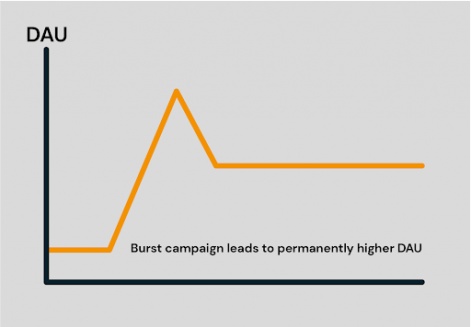Social First's President and Founder Mikko Kähärä tells PocketGamer.biz how the studio has found a way to effectively scale its games - cost-effectively - in a post-IDFA world.
Gaining and maintaining profitable UA has been a major headache in the post-IDFA world and rendered many games practically unscalable. At Social First, we have a validated model on how not only to bypass granular UA and IDFA, but also to scale games in a very cost-effective way.
Sustained organic growth can be boosted and managed. This is one of the main realisations we have based our business model on from day 1. The basis of the realisation comes from years of experience and experimentation with Pixel Worlds, a social sandbox MMO, that most of our team members worked on for several years prior to founding Social First. What we learned was that given a strong social gameplay, high accessibility (i.e. F2P and true cross-platform gameplay) and a healthy community, games can be permanently scaled with the help of the natural network effect of social gaming.
Bigger focus on Brand Marketing and the Network Effect
We managed to validate a growth model that works wonders with virality, long-term retention and ultimately, monetisation. Since we are using mostly wide-spectrum UA campaigns, akin to brand marketing, the model does not rely on IDFA or granular UA.
We stumbled on the effect basically by accident as part of our experimentations with UA and influencer campaigns. We boosted the traffic in limited geos to a high level with suitable influencer campaigns, supported by broad spectrum UA campaigns. After the campaigns ended and the traffic started dropping, we saw interesting results: the DAU levels plateaued at a significantly higher level than we started with, and we also saw a major increase in organic growth, retention and monetisation. This new level of DAU and performance became the new normal and evidently to have unlocked sustained organic growth.

Traffic is boosted to a high level with multi-channel marketing. After which, the daily active users (DAUs) plateaued at a significantly higher level than what we started with.
We repeated similar campaigns and tests in several geos with uncannily similar results. The model worked the same way regardless of the size of the target geo. The main explanation was that we managed to reach a critical mass of players needed to kickstart the network effect in our target audience in these geos. This means that in real-life circles of friends, if a couple or few members pick up a new game roughly at the same time, other members are likely to follow. Creating enough visibility and interest among the target audience helps to cross the threshold. Since no social circles are static, the effect spreads over time.
For early retention, there is a positive boost to “normal” traffic because your friend might be introducing the game to you personally and creating added motivation to learn the game (which is the best possible FTUE there is). If the game can offer a positive and socially rewarding experience, it also boosts long-term retention. You keep playing because your friends keep playing (old friends and new friends you have made in the game). Naturally, with strong retention and social pressure, there are more opportunities for efficient monetisation. As a growth model, this is very cost-effective: It only needs one-off, independent investments per geo with years and potentially decades of steady revenues.
Emphasis on social gameplay, community and player motivations
It's not simple though. There are a big number of factors at play that need to fall in place for the growth model to work properly. First, the game needs to provide a truly rewarding experience for the target audience and their social circles – It can’t be a hard sell to your friends. The game would need to cater for different kinds of player motivations in a balanced fashion (ie competitiveness, exploration, strategy, creativity etc.) and also have a high degree of accessibility (ie cross-platform on mobile, PC, consoles, everybody playing on their platform of choice; Not too aggressive F2P to keep cost of playing at a reasonable level). The social features and flow of the game needs to allow and incentivise for positive shared experiences in the long-term. This means creating different kinds of social contexts from shared creation processes to battles to just casual hang outs.
The community needs to maintain a positive, welcoming, and supporting vibe in both small and large scale. Active LiveOps with continuous content rollouts, events and features is needed to keep the community engaged and make sure there’s always something to talk about and share experiences. To further boost growth, encouraging players to share their experiences and creations and making the game fun also for a spectator can make a massive difference.
You also need to have a target audience that actually cares what their friends play and who are naturally social in their gameplay habits. This mostly means a younger crowd, ie Gen Z and Gen Alpha. Reaching out to these audiences previously with Pixel Worlds, we tested out numerous different kinds of UA and influencer campaigns (as you always should) - channels, creatives, messaging etc. What worked best was when we aligned our most efficient influencer campaigns with our UA content, and gave a very honest and straight-forward picture of the actual gameplay experience. No unnecessary noise or distractions. Making sure that the expectation and experience was in line with the actual gameplay experience with different features and content. Targeting especially Gen Z and Alpha with the aim of subjecting your game to a shared social decision to pick up the game, you don’t want to try to “seem” cool unless you know exactly what you are doing.
Though the growth model is no silver bullet to scale any game and with the burden that all marketing still needs to be tailor-made to serve the desired product-audience fit, the model is an extremely efficient way of scaling games when the elements align.
At Social First, our upcoming social sandbox MMO aims to tick all the main points from the list. Highly social, accessible, catering to different kinds of player motivations and built on years of experience in developing, managing, and marketing a similar title. Taking all that experience, analysis and understanding, along with an active legacy audience into account, we are creating a new social sandbox MMO that is super engaging, entertaining and performing. As a cherry on top, there are also major trends among Gen Z and Alpha that emphasize social gaming and creativity much more than before. Our upcoming title is very well positioned to ride that wave.






















